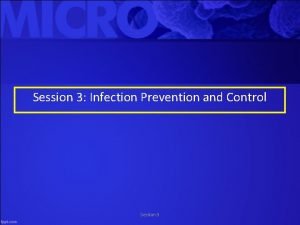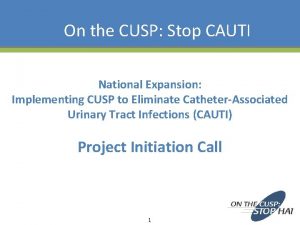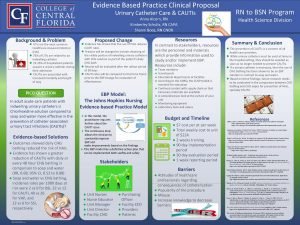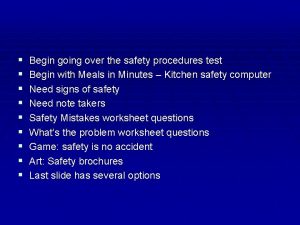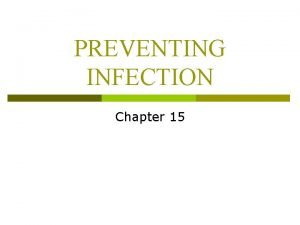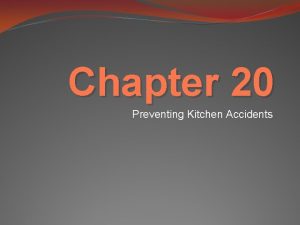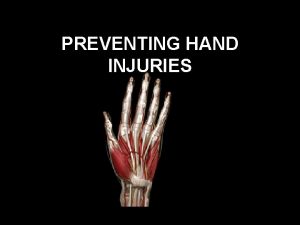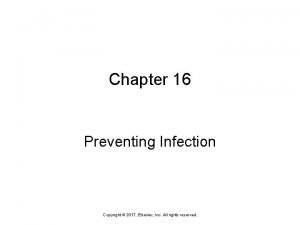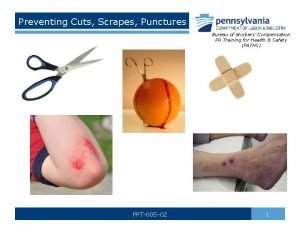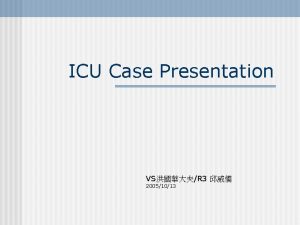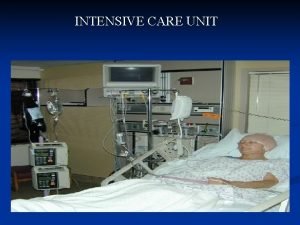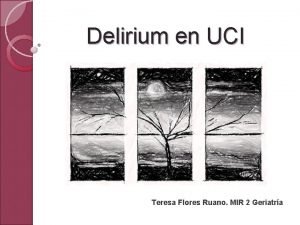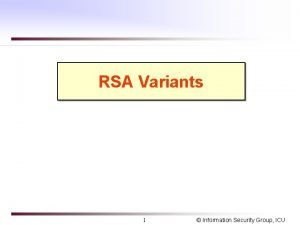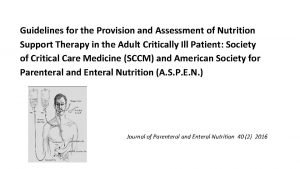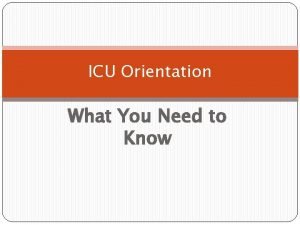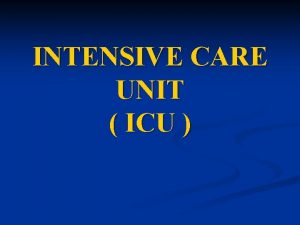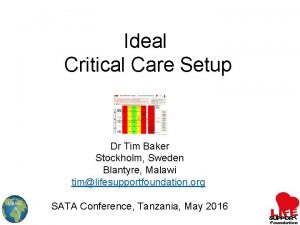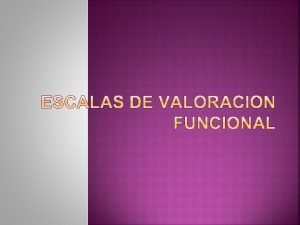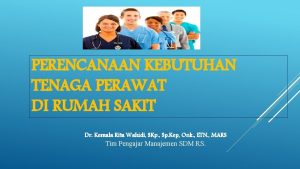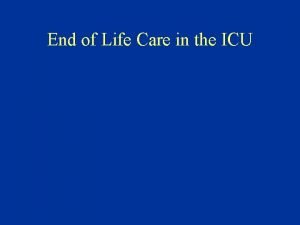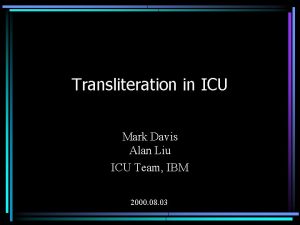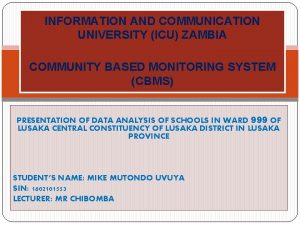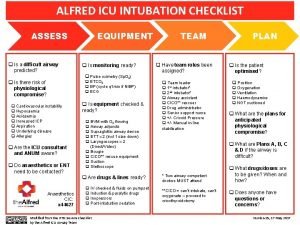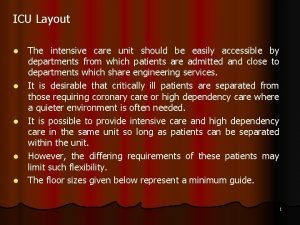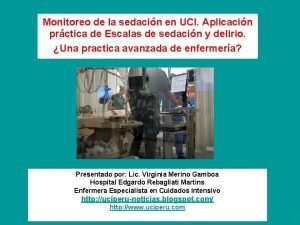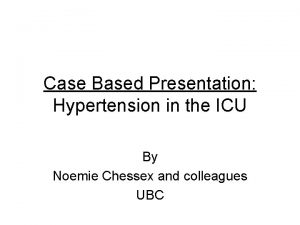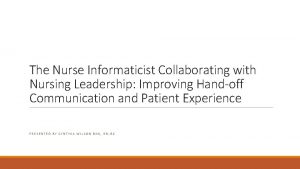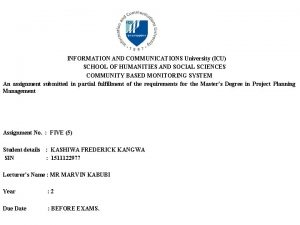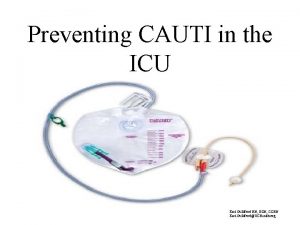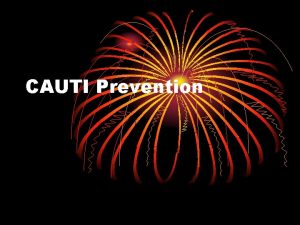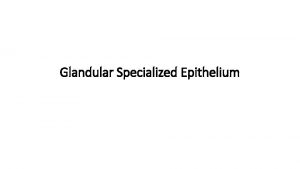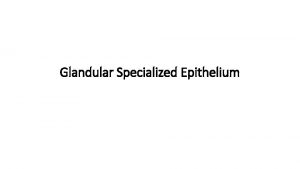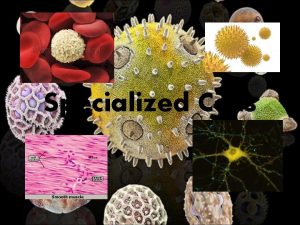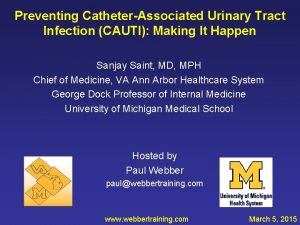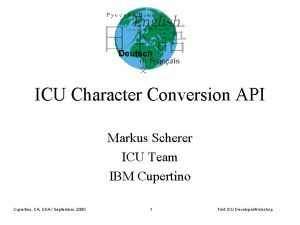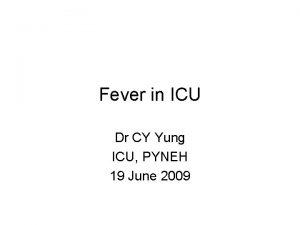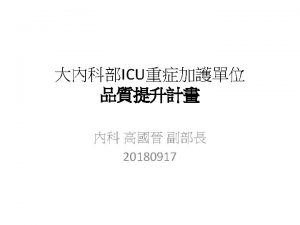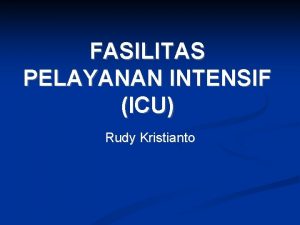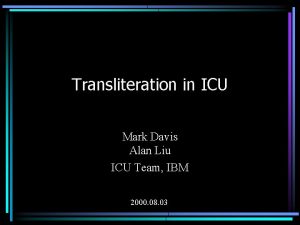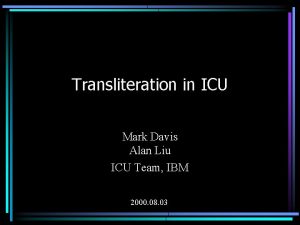Preventing CAUTI in Specialized Patient Populations The ICU
























































































- Slides: 88

Preventing CAUTI in Specialized Patient Populations: The ICU Hannah Wunsch, MD, MSc Herbert Irving Assistant Professor of Anesthesiology and Epidemiology Columbia University Eugene Chu, MD, FHM Director of Hospital Medicine Boulder Community Hospital Associate Clinical Professor of Medicine University of Colorado School of Medicine 1

Additional Presenters University Medical Center of Southern Nevada Las Vegas, NV Marlon Medina BSN, RN Ashley E. Komacsar BSN, RN 2

Learning Objectives 1. Describe the relationship between culture change and CAUTI reduction – Understand the CUSP framework for initiating culture change – Apply culture change theory to urinary catheter culture 2. Articulate the barriers to CAUTI reduction in the ICU population – Understand unique barriers in the ICU population – Compare reduction of CAUTIs with other similar issues in the care of ICU populations 3. Recognize the value in using incentives to change behavior regarding catheter use in the ICU – Using positive incentives to change behavior in regard to catheter use in the ICU – Catheter alternatives, nurse education, and engaging leadership 3

On the CUSP: Stop CAUTI Culture Change: The 4 E’s and the Elephant 4

Case 5

What is the cause of Ms. B’s hypoxia? a. Aspiration pneumonia b. Acute coronary syndrome with CHF c. Pneumothorax d. Pulmonary embolism 6

What is the cause of Ms. B’s hypoxia? a. Aspiration pneumonia b. Acute coronary syndrome with CHF c. Pneumothorax d. Pulmonary embolism 7

Case CAUTI Pressure ulcers Venous thromboembolism? Urinary Catheter Harm Immobility Falls? 8 Trauma *Saint S, Ann Intern Med 2002; 137: 125 -7 Increased Length of Stay Patient dignity*

Aims • Understand the CUSP framework for initiating culture change • Apply culture change theory to urinary catheter culture 9

Organizational Culture …the shared set of social values and beliefs, both explicit and implicit, that guides actions and decisions within the organization 10

Where do we intervene? ICU PACU/OR • Avoid insertion unless required for surgery • Remove promptly after surgery before transfer out • Evaluate for continued need • Discontinue no longer needed before transfer out Non-ICU Evaluate need on admission Evaluate for continued need 11 ED • Avoid initial placement • Reevaluate for continued need after patient stabilizes

CAUTI ICU Culture CAUTI Indications Orders HICPAC Insertion and Maintenance Technique Competency Removal Process Structure 12

Leading Change For anything to change, someone has to start acting differently. 13

Culture Change Theory 14

Changing Patient Safety Culture Senior leaders Team leaders Staff Engage How does this make the world a better place? Educate What do we need to do? What keeps me from doing it? Execute Evaluate 15 How can we do it with my resources? How do we know we improved safety?

Can you get people to start behaving in a new way? individual 16

Can you get people to start behaving in a new way? organization 17

Can you get people to start behaving in a new way? society 18

Can you get people to start behaving in a new way? educate engage execute and evaluate 19

Can you get people to start behaving in a new way? educate engage execute and evaluate 20

Can you get people to start behaving in a new way? educate engage execute and evaluate 21

Can you get people to start behaving in a new way? educate engage execute and evaluate 22

Population Health Improvement 23

Eat Healthy! 24

Use Skim Milk! 25

Use Skim Milk! 26

Can you get people to start behaving in a new way? What looks like resistance is often a lack of clarity. 27 Educate What do we need to do?

Education – Direct the Rider • HICPAC guidelines – Appropriate – Inappropriate • Aseptic insertion technique • Maintenance technique – Closed system • Skin care • Equipment usage – Bladder scanner – Condom cath – Female urinals

Taste Test 29

Which group attempted the puzzle for a longer time before giving up? a. The group that could eat the cookies b. The group that could only eat the radishes c. No difference 30

Which group attempted the puzzle for a longer time before giving up? a. The group that could eat the cookies b. The group that could only eat the radishes c. No difference 31

Can you get people to start behaving in a new way? What looks like laziness is often exhaustion. 32 Engage How does this make the world a better place?

Engage – Patients CAUT I Pressur e ulcers Venous thromboembolism? Falls? 33 Immobili ty Urinar y Cathet er Harm Traum a *Saint S, Ann Intern Med 2002; 137: 125 -7 Increased Length of Stay Patient dignity*

Engage – Finances 34 Daily Census ALOS Yearly Admits Foley Rate Annual Savings 800 4 73, 000 25% $1. 1 M 400 4 36, 500 25% $552 k 200 4 18, 250 25% $276 k www. catheterout. org

Engage – Vision • • • 35 Imaginable Feasible Desirable Focused Flexible Communicable

Don’t Forget the Cookies 36

Free Popcorn 37

What characteristics were different between the groups? a. Age b. Gender c. BMI d. All of the above e. None of the above 38

What characteristics were different between the groups? a. Age b. Gender c. BMI d. All of the above e. None of the above 39

Can you get people to start behaving in a new way? What looks like a people problem is often a situation problem. Execute 40 Evaluate What keeps me from doing it? How can we do it with my resources? How do we know we improved safety?

Execute – Structure 41

Execute – Processes Orders with indications Nurse driven removal protocol Acute urinary retention protocol Insertion and maintenance competency evaluations • ED and OR -> ICU processes • Monitoring and Feedback • • 42

Evaluation • Use data to assess progress: – Hospital Survey on Patient Safety – Infection rates – Process measures – Organizational and team culture 43

Can you get people to start behaving in a new way? educate engage execute and evaluate 44

Organizational Culture …the shared set of social values and beliefs, both explicit and implicit, that guides actions and decisions within the organization 45

CAUTI ICU Culture CAUTI Indications Orders HICPAC Insertion and Maintenance Technique Competency Removal Process Structure 46

Learning Objectives 1. Understand unique barriers in the ICU population 2. Compare reduction of CAUTIs with other similar issues in the care of ICU populations 47

Last patient of the morning (11: 45 a. m. ) • 75 yo M • Hx of HTN, DM 2 • Admitted 24 hours earlier “for monitoring” after a pancreaticoduodenectomy (Whipple) • Doing well, good UOP, no vasopressors Would you remove the urinary catheter as part of your plan for the day? 48

Why do ICU patients feel ‘special’? • “if you touch them they desaturate” • “they are on high doses of vasopressors and their kidney function is tenuous” • “they are at high risk for a sacral decub” • “they are at risk for abdominal compartment syndrome and I’m monitoring UOP” • They are “sick” and we need to know “ins and outs” every hour The need for urinary catheters in the ICU will never go away 49

So why is it so hard to change things? • What is YOUR biggest barrier? – The nurse/physicians in the unit want to take the Foley out, but the surgeon/oncologist also caring for the patient wants it in – Everyone still wants ‘ins and outs’ every hour – There are so many other things to discuss on rounds 50

So why is it so hard to change things? • What is your biggest barrier? – The nurse/physicians in the unit want to take the Foley out, but the surgeon/oncologist also caring for the patient wants it in – Everyone still wants ‘ins and outs’ every hour – There are so many other things to discuss on rounds 51

ICU care is complex even in a ‘closed’ unit • ICU – Intensivist – Pharmacist – Respiratory therapist – Nurse – Surgeon – Infectious disease specialist – (Resident) 52 • Emergency medicine – EM physician – Nurse

Time frame • Time for care in the ED is short • Time for care in the ICU is long 53

So why is it so hard to change things? • What is your biggest barrier? – The nurse/physicians in the unit want to take the Foley out, but the surgeon/oncologist also caring for the patient wants it in – Everyone still wants ‘ins and outs’ every hour – There are so many other things to discuss on rounds 54

It used to be… • ‘everyone still wants a wedge pressure on every sick patient’ 55

Trend from 1993 to 2004 Soylemez Wiener & Welch JAMA 2007 56

57 Gershengorn & Wunsch CCM 2013

Understanding Changes in Established Practice Gershengorn & Wunsch CCM 2013 58

59 Gershengorn & Wunsch CCM 2013

So why is it so hard to change things? • What is YOUR biggest barrier? – The nurse/physicians in the unit want to take the Foley out, but the surgeon/oncologist also caring for the patient wants it in – Everyone still wants ‘ins and outs’ every hour – There are so many other things to discuss on rounds 60

Back to the 4 Es (sort of) -Engage -Educate ****Empower ***** -Execute ****Celebrate***** -(Evaluate) 61

A lot of people – and you only need one • • • 62 Nurse Pharmacist Physical Therapist Respiratory Therapist PA NP Fellow Resident Medical Student

Example of empowerment… 63

ICU is a lot of ‘doing’ • • 64 Place the Foley Place the central line Monitor Ins and Outs Place the arterial line Send off the ABG Intubate Change the ventilator settings Order another test

Human Nature Linda Lewis “Don’t just do something, stand there” 65

Celebrate the ‘removal’ 66

On the CUSP: Stop CAUTI A Journey to Prevent CAUTI & Improve Patient Safety in the ICU University Medical Center of Southern Nevada Las Vegas, NV Marlon Medina BSN, RN Ashley E. Komacsar BSN, RN 67

On the CUSP at UMC ü Attended statewide implementation meeting q Form a dedicated CAUTI team q Participate in HSOPs survey q Review current catheter policy and order set q CAUTI rounds with executive champion q Team member participation in national and statewide coaching calls q Attend statewide Learning Session 2 q Attend learning session 3/project wrap-up q Sustain the culture of change 68

Formation of CAUTI Team • Unit Manager – For support, leadership, & time allocation • Unit Charge Nurses – For support, consistency, resource, & data collection • Unit Team Leader – Peer champion, coordinate project efforts, staff empowerment • Staff Nurses – Heart of operation, implement CUSP at the bedside • Infection Control – Data collection & submission, coordination of house-wide efforts • Physician Champion – Support change at physician level, coordinate multidisciplinary care • Executive Champion – Administrative support, allocation of resources 69

Review of Policy & Practice 2012 • Physician Foley Daily Order Form – Physician to order Foley with approved indication – Physician to assess daily if catheter meets indication • Daily Bundle Checklist – Daily tasks for best practice (i. e. Bag below bladder, use of securement device, seal not broken) – Nurse to complete when care on sheet is completed 70

Executive Champion CAUTI Rounds • Our Chief Financial Officer & Executive Champion was invited to round on the unit • Explanation of CUSP given • A chance to interact with staff and voice safety concerns • Attended Bard catheter training class with CAUTI team members 71

Team Member Participation • National Content Calls – Tuesdays once monthly – Different and guest speakers present information on various areas within CUSP • State Coaching Calls – Once monthly – State data shared – A chance for hospitals to network and exchange progress and offer assistance • CAUTI Team Unit Meetings – – 72 Quarterly Perform analysis of CAUTI incidents Reflect on state and national content Brainstorm and implementation of projects within unit

Learning Session 2 & 3 • April 16, 2013 in Reno, NV • February 7, 2014 in Reno, NV • Presentations from Nevada • Project wrap-up and final data hospitals presentation – Saint Mary’s, Renown, • Sharing greatest successes & Tahoe Pacific barriers • Identifying Barriers • Culture Sustainment – Education, Increased • Awards Presentation Workload, Participation, Resources, Foley Alternatives • Learning from Defects • Prevention Strategies • Culture Change & Sustainment • Teamwork in Action • Team Sharing and Action Plan • Staff Safety Assessment 73 Discussion

On the CUSP in Action • Changes on NSCU – – – CUSP Information boards assembled Foley Decision tree in every room Development of CAUTI Alert Increased staff vigilance and catheter removal Continued attendance of calls and regular meetings • House-Wide Changes – – – 74 Bard sponsored Foley Catheter Class & new departmental testing Providing and utilizing more Catheter Alternatives Change in stocking of urinary catheter trays Revision/Update of Foley policy Nurse-Driven Foley removal

CUSP Information Boards • First CUSP project for NSCU • Created after CUSP implementation • Provides information on CUSP • Provides information on CAUTI • Used to engage staff, physicians, & family in unit project 75

Foley Decision Tree • Placed in every room • Insert date placed in top yellow diamond • Contain indications for catheter & maintenance • Makes indications visible to patient family and staff 76

CAUTI Alert • Tool to alert staff of a CAUTI • Lists date & time of event • Cites NHSN criteria for event labeled as a CAUTI • Raises awareness of incident for use for further prevention 77

Foley Catheter Training • Bard was invited to provide classes reviewing the product and current insertion and maintenance techniques • UMC department of Clinical Research & Education put together a departmental test placed on the UMC intranet for staff • Lab time also arranged for a “test out” on care and insertion • CAUTI Prevention incorporated into “Skills Fair” for floor specific competencies 78

Catheter Alternatives • Began to reinforce use of catheter alternatives such as the condom catheter – Educate on proper application technique – In-service on application of the Liberty condom Catheter • Pilot use of the female urinal – Began a house-wide in-service on female urinal use after successful pilot on NSCU – Well received by staff and patients – Direct in-servicing provided to near 200 employees house-wide by NSCU’s CUSP team • Posters developed with tips for incontinence care and available continence devices 79

Tips for Female Urinal Use • Present the device to the patient; explain that it is a device to collect urine • Assist the patient in placing the urinal flat side down, handle up between the patient’s legs flush to the perineum • Adjust patient’s head to an upright position for comfort 80

Change in Stock of Catheter Trays • Prior to project, both trays with a conventional drainage bag and urimeter trays were stocked in the ED & OR • Often times, seal was being broken when pt received in ICU to place a temp sensing/urimeter drainage bag • Skin Council & Supply collaborated to place urinary catheter trays in ED & OR to allow for more appropriate product placement 81

Getting the students involved • Students are educated about On the CUSP: Stop CAUTI • Students created CAUTI prevention display as their unit project • Presented findings to staff and created care checklist for Foley care in patient rooms • Staff took great pride collaborating with students 82 and sharing knowledge

Brags • News of success house-wide – Presented at IC meetings • Administrative support for continuing effort – Support for Nurse-Driven Removal Protocol • Empowering staff to participate in activities beyond the bedside • Opportunities to share our story with hospitals in the community – Keynote Presentation for Winter Plenary QIO Session • Awards presented for NSCU’s work at Learning Session 3 • Article appearing in hospital newsletter The Pulse 83 • Participation in CDC sponsored “Reverse the Trend” Webinar • Interview appearing in edition of APIC’s Prevention Strategist

Barriers • Physician Buy-in • Time & resources – Securing more commodes, finding times to meet, funding • Staff schedule & availability – Low census, floating • Competing Project Rollouts – EMR implementation – Competing Project Rollouts • Administrative Changes • Fear about life without a Foley, “New Trick Anxiety” 84

How are We Doing? • Staff is advocating for Foley removal when not indicated • Staff really taking ownership of CAUTI when occurring, reviewing what could be done • Physicians on ICU Team assess for indication during daily rounds • Catheter alternatives are used on a regular basis • Infection Control reports less investigation of CAUTI incidents • Foley Policy revised to reflect best practice including Nurse-driven Foley removal • Plaques and articles displayed in the units • Continuing to coordinate with Performance Improvement, Infection Control, Education, & other departments to reduce CAUTI • Continuing to develop program to continue moving towards ZERO CAUTI 85

Thank You Thank you 86

Thank you! Questions? 87

Funding Prepared by the Health Research & Educational Trust of the American Hospital Association with contract funding provided by the Agency for Healthcare Research and Quality through the contract, “National Implementation of Comprehensive Unit-based Safety Program (CUSP) to Reduce Catheter-Associated Urinary Tract Infection (CAUTI), project number HHSA 290201000025 I/HHSA 29032001 T, Task Order #1. ” 88
 Cauti prevention bundle checklist
Cauti prevention bundle checklist Stop cauti
Stop cauti Pico question for cauti
Pico question for cauti Complex patient populations
Complex patient populations Patient 2 patient
Patient 2 patient Chapter 9 resolving conflicts and preventing violence
Chapter 9 resolving conflicts and preventing violence Preventing ageing unequally
Preventing ageing unequally Preventing kitchen accidents worksheet
Preventing kitchen accidents worksheet Chapter 15 preventing infection
Chapter 15 preventing infection Chapter 4 preventing injuries through fitness
Chapter 4 preventing injuries through fitness Chapter 20 preventing kitchen accidents
Chapter 20 preventing kitchen accidents Which is mainly responsible for preventing erosion
Which is mainly responsible for preventing erosion How do empathy theories prevent discrimination
How do empathy theories prevent discrimination Preventing hand injuries
Preventing hand injuries Chapter 16 preventing infection
Chapter 16 preventing infection Chapter 9 resolving conflicts and preventing violence
Chapter 9 resolving conflicts and preventing violence Chapter 24 lesson 2 preventing and treating stds
Chapter 24 lesson 2 preventing and treating stds Work comp puncture
Work comp puncture Chapter 14:1 using body mechanics
Chapter 14:1 using body mechanics Chapter 13:2 preventing accidents and injuries
Chapter 13:2 preventing accidents and injuries Icu indication
Icu indication Normal saline uses
Normal saline uses Icu case presentation
Icu case presentation Intensive care unit definition
Intensive care unit definition Cam icu escala
Cam icu escala Icu localization
Icu localization Icu unicode
Icu unicode Shanks algorithm example
Shanks algorithm example Kp icu jpm
Kp icu jpm Patient acuity tool
Patient acuity tool Sean forsythe
Sean forsythe Diet chart for icu patients
Diet chart for icu patients Icu case presentation
Icu case presentation Icu orientation
Icu orientation Icu primer
Icu primer Icu security group
Icu security group Escala cam icu
Escala cam icu Ideal icu setup
Ideal icu setup Icu library
Icu library Escala nivel de consciencia
Escala nivel de consciencia Cheetah nicom monitor
Cheetah nicom monitor Perhitungan jumlah tenaga perawat menurut depkes
Perhitungan jumlah tenaga perawat menurut depkes End of life care in icu
End of life care in icu Icu transliterator
Icu transliterator Icu for dummies
Icu for dummies Emphancy
Emphancy Alfred icu
Alfred icu Lidocaine dose calculator
Lidocaine dose calculator Icu layout and design
Icu layout and design Abcde methode ehbo
Abcde methode ehbo Language
Language Caso clínico
Caso clínico Lasix to bumex conversion
Lasix to bumex conversion Icu case presentation
Icu case presentation Icu medical b3108
Icu medical b3108 List of lecturers at icu zambia
List of lecturers at icu zambia Công thức tính thế năng
Công thức tính thế năng Thế nào là mạng điện lắp đặt kiểu nổi
Thế nào là mạng điện lắp đặt kiểu nổi Hình ảnh bộ gõ cơ thể búng tay
Hình ảnh bộ gõ cơ thể búng tay Lời thề hippocrates
Lời thề hippocrates Dạng đột biến một nhiễm là
Dạng đột biến một nhiễm là Vẽ hình chiếu đứng bằng cạnh của vật thể
Vẽ hình chiếu đứng bằng cạnh của vật thể độ dài liên kết
độ dài liên kết Các môn thể thao bắt đầu bằng tiếng nhảy
Các môn thể thao bắt đầu bằng tiếng nhảy Sự nuôi và dạy con của hươu
Sự nuôi và dạy con của hươu điện thế nghỉ
điện thế nghỉ Một số thể thơ truyền thống
Một số thể thơ truyền thống Biện pháp chống mỏi cơ
Biện pháp chống mỏi cơ Trời xanh đây là của chúng ta thể thơ
Trời xanh đây là của chúng ta thể thơ Chó sói
Chó sói Các số nguyên tố là gì
Các số nguyên tố là gì Thiếu nhi thế giới liên hoan
Thiếu nhi thế giới liên hoan Tia chieu sa te
Tia chieu sa te Các châu lục và đại dương trên thế giới
Các châu lục và đại dương trên thế giới Thế nào là hệ số cao nhất
Thế nào là hệ số cao nhất Sơ đồ cơ thể người
Sơ đồ cơ thể người Tư thế ngồi viết
Tư thế ngồi viết đặc điểm cơ thể của người tối cổ
đặc điểm cơ thể của người tối cổ Mật thư anh em như thể tay chân
Mật thư anh em như thể tay chân Chụp tư thế worms-breton
Chụp tư thế worms-breton Bổ thể
Bổ thể Tư thế ngồi viết
Tư thế ngồi viết ưu thế lai là gì
ưu thế lai là gì Thẻ vin
Thẻ vin Cái miệng nó xinh thế chỉ nói điều hay thôi
Cái miệng nó xinh thế chỉ nói điều hay thôi Thơ thất ngôn tứ tuyệt đường luật
Thơ thất ngôn tứ tuyệt đường luật Các châu lục và đại dương trên thế giới
Các châu lục và đại dương trên thế giới Từ ngữ thể hiện lòng nhân hậu
Từ ngữ thể hiện lòng nhân hậu
